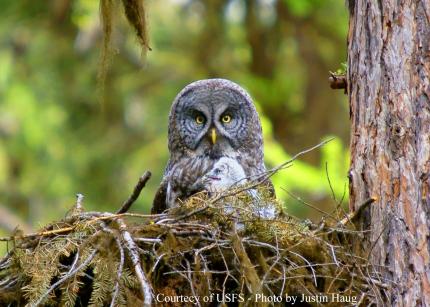Moderate
The population of great gray owl in Washington is estimated to be very small. It is a rare local breeder in areas of the northern part of the state.
Description and Range
Physical description
Measuring up to 27 inches in length, the great gray owl is the largest owl in North America. It has yellow eyes and a large rounded head and facial disk.
Ecology and life history
Great gray owls use mature conifer forests of Douglas fir, western larch, ponderosa pine, Engelmann spruce, subalpine fir, and lodgepole pine adjacent to their foraging areas in openings and wet meadows, sometimes in association with quaking aspen.

Great gray owls nest in larger broken-topped snags, clusters of mistletoe-infected branches, and nests built by other species, often those of northern goshawk or red-tailed hawk.
The great gray owl is one of the least studied owl species in Washington. Research in other regions indicates that their diet is dominated by voles and pocket gophers.
Most great gray owls breed by three years of age, although some pairs may not breed in years of low prey abundance
Geographic range
The range of the great gray owl is circumpolar in northern latitudes. In North America, its range is northern boreal coniferous forest habitat, south through the Cascade Mountains, the northern Rocky Mountains, and Sierra Nevada Mountains.
The great gray owl is a rare local breeder in parts of northern Washington, such as the Okanogan Highlands (and perhaps other locations). A nest with young was documented in the WDFW Chesaw Wildlife Area in recent years. It is a rare winter visitor elsewhere in the state, occasionally including lowland areas. Records from a century ago suggest the species formerly nested at low elevations in western Washington.
The population in Washington is estimated to be very small (likely fewer than 20 to 40 territories), although fidelity to breeding sites can be transitory due to low prey numbers.
For a map of range-wide distribution and conservation status of this species, check out NatureServe Explorer.
Climate vulnerability
Sensitivity to climate change
Moderate
Plumage of great gray owls may make this species somewhat sensitive to warmer temperatures, although underwing apteria may help dissipate heat. Great gray owls may also exhibit some sensitivity to disturbance regimes such as fire and wind that destroy suitable habitat.
Exposure to climate change
Moderate
- Increased temperatures
- Altered fire regimes
- High wind events
Conservation
Conservation Threats and Actions Needed
- Resource information collection needs
- Threat: Recent threats not clear.
- Actions Needed: Conduct surveys of habitat and and owls to increase knowledge.
See the Climate vulnerability section for information about the threats posed by climate change to this species.
Resources
References
Anderson, C. M. and K. Woodruff. 2005. Great Gray Owl (Strix nebulosa). Pp 219-220 in T. R. Wahl, B. Tweit, and S. G. Mlodinow (eds.) Birds of Washington: Status and Distribution. Oregon State University Press, Corvallis, OR, USA. 436 pp.
Bull, E. L. and J. R. Duncan. 1993. Great Gray Owl (Strix nebulosa). The Birds of North America 41:1-1.
Bull, E. L. and J. R. Duncan (2020). Great Gray Owl (Strix nebulosa), version 1.0. In Birds of the World (S. M. Billerman, Editor). Cornell Lab of Ornithology, Ithaca, NY, USA. https://doi.org/10.2173/bow.grgowl.01

.jpg?crop=no&k=c&w=860&h=645)
.jpg?crop=no&k=c&w=860&h=645)

